SWRS196I January 2018 – February 2021 CC1352R
PRODUCTION DATA
- 1 Features
- 2 Applications
- 3 Description
- 4 Functional Block Diagram
- 5 Revision History
- 6 Device Comparison
- 7 Terminal Configuration and Functions
-
8 Specifications
- 8.1 Absolute Maximum Ratings
- 8.2 ESD Ratings
- 8.3 Recommended Operating Conditions
- 8.4 Power Supply and Modules
- 8.5 Power Consumption - Power Modes
- 8.6 Power Consumption - Radio Modes
- 8.7 Nonvolatile (Flash) Memory Characteristics
- 8.8 Thermal Resistance Characteristics
- 8.9 RF Frequency Bands
- 8.10 861 MHz to 1054 MHz - Receive (RX)
- 8.11 861 MHz to 1054 MHz - Transmit (TX)
- 8.12 861 MHz to 1054 MHz - PLL Phase Noise Wideband Mode
- 8.13 861 MHz to 1054 MHz - PLL Phase Noise Narrowband Mode
- 8.14 359 MHz to 527 MHz - Receive (RX)
- 8.15 359 MHz to 527 MHz - Transmit (TX)
- 8.16 359 MHz to 527 MHz - PLL Phase Noise
- 8.17 143 MHz to 176 MHz - Receive (RX)
- 8.18 143 MHz to 176 MHz - Transmit (TX)
- 8.19 143 MHz to 176 MHz - PLL Phase Noise
- 8.20 Bluetooth Low Energy - Receive (RX)
- 8.21 Bluetooth Low Energy - Transmit (TX)
- 8.22 Zigbee and Thread - IEEE 802.15.4-2006 2.4 GHz (OQPSK DSSS1:8, 250 kbps) - RX
- 8.23 Zigbee and Thread - IEEE 802.15.4-2006 2.4 GHz (OQPSK DSSS1:8, 250 kbps) - TX
- 8.24 Timing and Switching Characteristics
- 8.25 Peripheral Characteristics
- 8.26 Typical Characteristics
- 9 Detailed Description
- 10Application, Implementation, and Layout
- 11Device and Documentation Support
- 12Mechanical, Packaging, and Orderable Information
Package Options
Refer to the PDF data sheet for device specific package drawings
Mechanical Data (Package|Pins)
- RGZ|48
Thermal pad, mechanical data (Package|Pins)
- RGZ|48
Orderable Information
8.26.3 TX Current
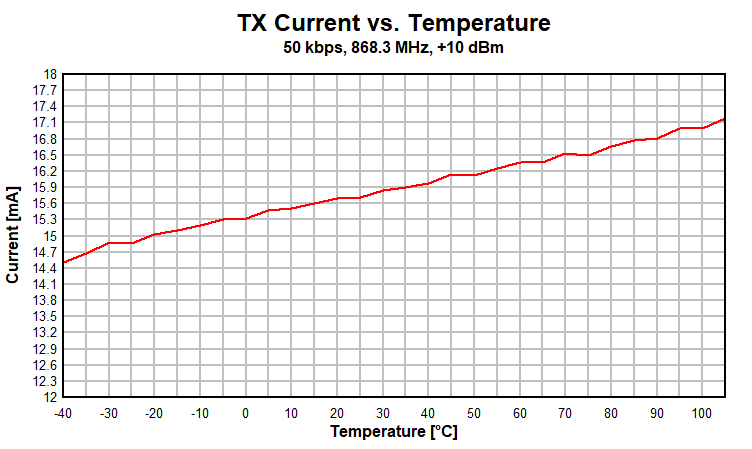 Figure 8-12 TX Current vs.
Figure 8-12 TX Current vs.Temperature (50 kbps, 868.3 MHz)
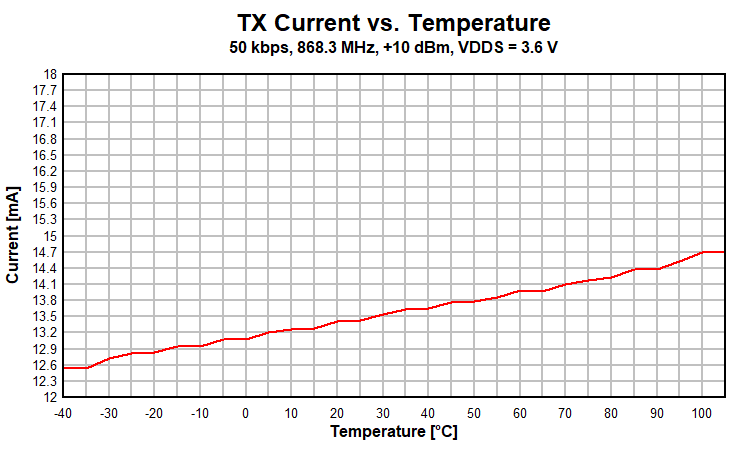 Figure 8-13 TX Current vs.
Figure 8-13 TX Current vs.Temperature (50 kbps, 868.3 MHz, VDDS = 3.6 V)
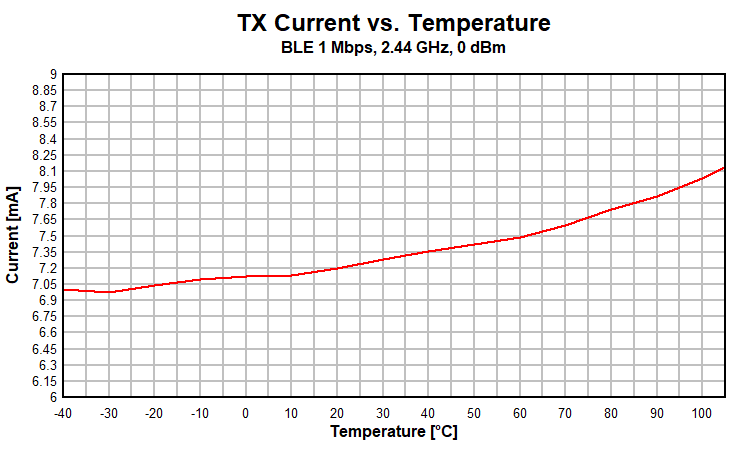 Figure 8-14 TX Current vs.
Figure 8-14 TX Current vs.Temperature (BLE 1 Mbps, 2.44 GHz)
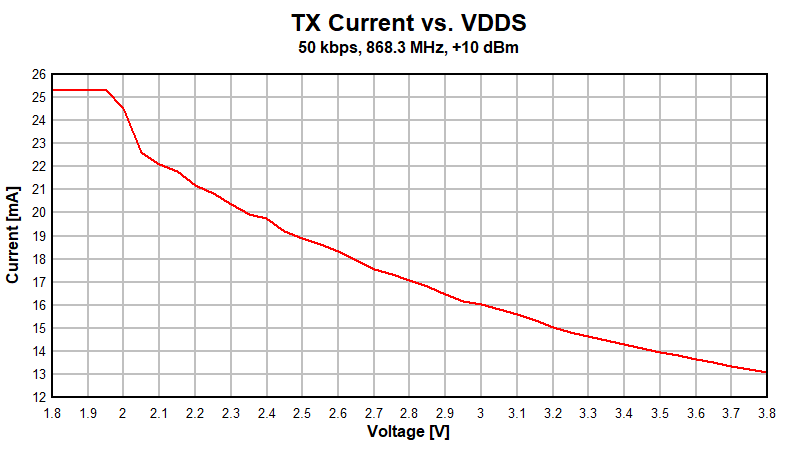 Figure 8-15 TX Current vs.
Figure 8-15 TX Current vs.Supply Voltage (VDDS) (50 kbps, 868.3 MHz)
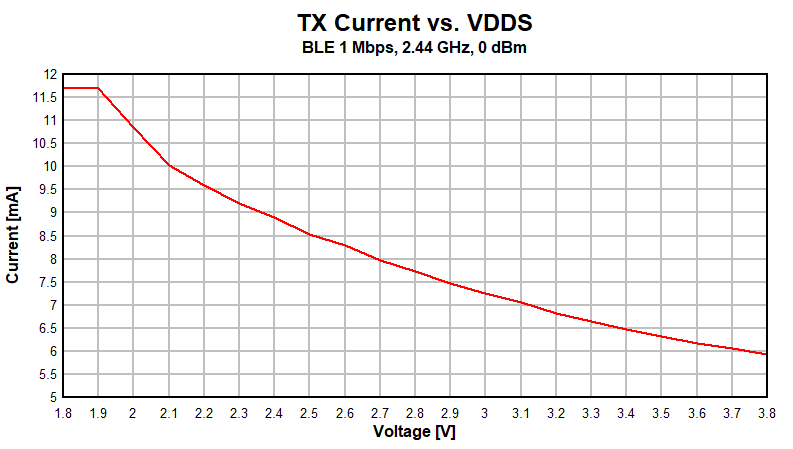 Figure 8-16 TX Current vs.
Figure 8-16 TX Current vs.Supply Voltage (VDDS) (BLE 1 Mbps, 2.44 GHz)
Table 8-1 and Table 8-2 show typical TX current and output power for different output power settings.
Table 8-1 Typical TX Current and Output Power (915 MHz, VDDS = 3.6 V)
| CC1352R at 915 MHz, VDDS = 3.6 V (Measured on CC1352REM-XD7793-XD24) | |||
|---|---|---|---|
| txPower | TX Power Setting (SmartRF Studio) | Typical Output Power [dBm] | Typical Current Consumption [mA] |
| 0x013F | 14 | 13.6 | 24.2 |
| 0xB224 | 12.5 | 12 | 17.6 |
| 0xA410 | 12 | 11.5 | 16.5 |
| 0x669A | 11 | 10.5 | 14.9 |
| 0x3E92 | 10 | 9.4 | 13.5 |
| 0x3EDC | 9 | 8.5 | 12.7 |
| 0x2CD8 | 8 | 7.7 | 11.9 |
| 0x26D4 | 7 | 6.5 | 11 |
| 0x20D1 | 6 | 5.4 | 10.2 |
| 0x1CCE | 5 | 3.8 | 9.3 |
| 0x16CD | 4 | 3.2 | 9 |
| 0x14CB | 3 | 1.7 | 8.3 |
| 0x12CA | 2 | 0.8 | 8 |
| 0x12C9 | 1 | -0.3 | 7.6 |
| 0x10C8 | 0 | -1.4 | 7.3 |
| 0x0AC4 | -5 | -8.6 | 5.8 |
| 0x0AC2 | -10 | -15.9 | 5.1 |
| 0x06C1 | -15 | -22.3 | 4.8 |
| 0x04C0 | -20 | -24.4 | 4.6 |
Table 8-2 Typical TX Current and Output Power (2.4 GHz, VDDS = 3.0 V)
| CC1352R at 2.4 GHz, VDDS = 3.0 V (Measured on CC1352REM-XD7793-XD24) | |||
|---|---|---|---|
| txPower | TX Power Setting (SmartRF Studio) | Typical Output Power [dBm] | Typical Current Consumption [mA] |
| 0x7217 | 5 | 4.4 | 9.6 |
| 0x4E63 | 4 | 3.0 | 8.9 |
| 0x385D | 3 | 1.8 | 8.3 |
| 0x3259 | 2 | 0.7 | 7.9 |
| 0x2856 | 1 | -0.3 | 7.5 |
| 0x2853 | 0 | -1.5 | 7.1 |
| 0x12D6 | -5 | -6.7 | 6.1 |
| 0x0ACF | -10 | -11.5 | 5.5 |
| 0x06CA | -15 | -16.7 | 5.1 |
| 0x04C6 | -20 | -22.7 | 4.8 |